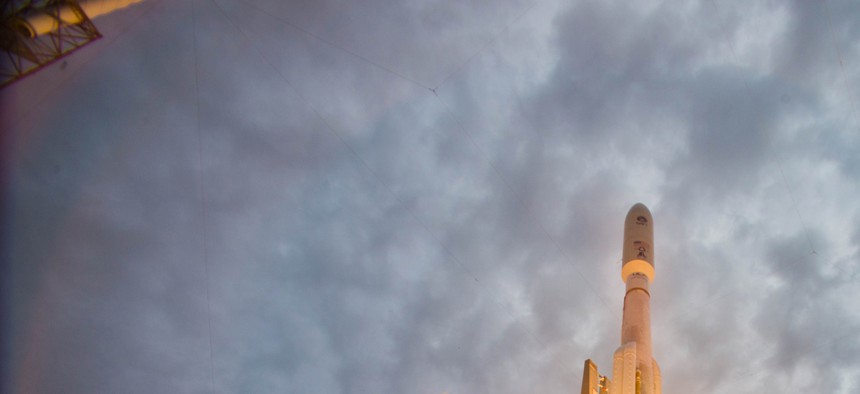
An Atlas V rocket launches the Navy's Mobile User Objective System (MUOS) 2 satellite from Space Launch Complex-41 at Cape Canaveral Air Force Station, Fla., July 19, 2013. U.S. Navy photo courtesy of NASA by Patrick H. Corkery/Released
Let Air Force Run the Military Satellites, Watchdog Argues
It’s been a long time since TSAT. A new report says the Pentagon should let the Air Force control the next-generation MILSATCOM architecture to save money and add security. It’s not that simple, though. By Kevin Baron
Here’s a crazy idea for the Pentagon: consolidate all of the military’s communications satellites under the command of one service, the Air Force. That way, program offices and their budgets will fall under the same chain of command, saving the military -- and the taxpayers and the satellite makers -- a whole lot of time and money.
It’s one of several recommendations for building a so-called next-generation MILSATCOM (military satellite communications) architecture found in a report released Wednesday by the Center for Strategic and Budgetary Assessments. The group argues it's time the Defense Department begins thinking about how to overhaul the Cold War-era satellite network and its management, to be more secure and more affordable.
The problem, or goal, is to figure out how to synchronize the funding and management of the military’s satellite programs. Of course, CSBA’s Todd Harrison, senior fellow for defense budget studies, again has come up with an obviously simple plan for the Pentagon that would streamline everything into a nice, commonsense package: Give them to the Air Force.
“It’s that decentralization and the misalignment of program structures and funding structures that create the problem of synchronization in MILSATCOM systems. And it’s a significant program, and it’s creating inefficiencies,” Harrison told Defense One. “The only way that I see that we can effectively manage synchronization is to align those budgets and programs along the chain of command of one service.
Otherwise I think we’re destined to see these kinds of problems.”
But, as with all things DOD, it’s not so simple.
The military’s satellite net, Harrison explained, handles three kinds of communications: narrowband, for voice, mobile and ultra high frequency (UHF) signals; wideband, for high data and video transmissions; and protected, which provides hardened capabilities for extremely high frequency (EHF) and others. The Pentagon had a plan for a new, modern satellite architecture called the Transformation Satellite Communications System, and known as TSAT. In 2009, then-Defense Secretary Robert Gates canceled the system as an exquisite wish-list item the U.S. could ill afford while the Iraq war lingered. Instead, the services were directed to continue buying what they already were buying: the Navy’s narrowband Mobile User Objective System (MUOS), the Wideband Global SATCOM (WGS), and the protected Advanced EHF (AEHF).
So why propose a change now? Harrison said with wars ending, cybersecurity concerns rising, and a Pacific pivot requiring the U.S. to leverage capabilities to its allies, it’s time. This is not a pitch to get into the Quadrennial Defense Review or even next year’s budget request, he said. This is something for Pentagon planners -- and Navy and Army program chiefs -- to chew on for two to three years.
“Obviously the Air Force has had problems of their own,” Harrison said. “This is by no means a cure-all and I’m sure the other services are going to question the Air Force’s ability to do this. I think that’s fair. But do the other services really want to the be the ones taking this on? Isn’t the Air Force the natural fit?”
But CSBA’s report, as with most analysis of military satellites, is only half of the picture: the unclassified half. The National Reconnaissance Office, or NRO, and the National Geospatial Intelligence Agency, or NGA, are omitted from Harrison’s report completely. Harrison said he can only speak about unclassified activity. But these are the intelligence agencies that deal with the “black side” of the satellite architecture. Any recommendations to changing the MILSATCOM architecture should require intimate knowledge and integration of the black side, a former government official with knowledge of intelligence programs told Defense One.
“Someone who has access to both sides, which is someone of the black side, is probably better suited to do that,” said the official. For one, “the challenge of moving it to the Air Force is that the Navy has very specific weather requirements that the Air Force does not prioritize in the same way… We’re talking about current patterns.” And the public should not assume the acquisitions process for secret capabilities is any better.
For now, Harrison’s report is a detailed conversation starter, at least. “MILSATCOM systems are arguably just as vulnerable to cost overruns, funding instability, and other programmatic factors that can prevent a satellite from ever getting off the ground as they are to physical, electronic and cyber attacks,” the report argues. “MILSATCOM acquisitions are technologically complex with long development and production schedules and relatively small procurement quantities. These factors tend to reinforce one another in what has been called the ‘vicious cycle of space acquisition': higher costs lead to smaller constellations and longer production times; smaller constellations require more capabilities to be packed into each satellite; and packing more capabilities into each satellite drives up complexity, leading to even higher costs and longer production times.”
Welcome to the new era.
NEXT STORY: House Approves 1.8 Percent Military Pay Raise




